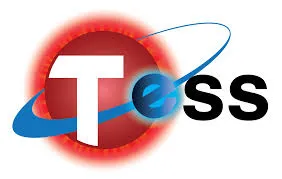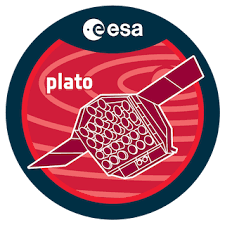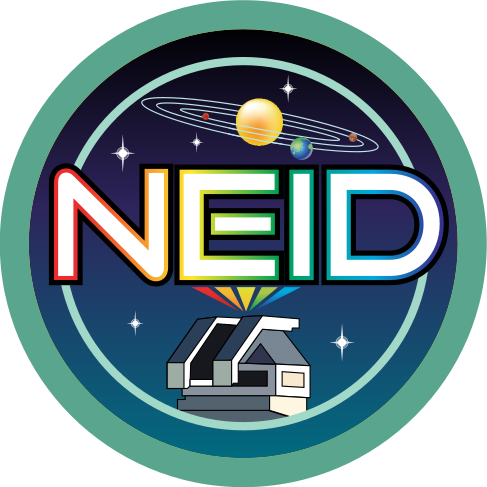Lauren Doyle
I am a Research Fellow based at Warwick University working with Dr. David Armstrong and Dr. Daniel Bayliss using TESS data to search for non-transiting planets in phase curves. My main research interests lie in stellar variability, such as flares and starspots, and the impact they can have on orbiting exoplanet atmospheres and exoplanet detection.
I studied for my Ph.D. at Armagh Observatory and Planetarium and Northumbria University where my thesis title was ‘Solar and Stellar Flares and Their Connection’. I kick-started my academic career in solar flare research investigating Doppler velocities through spectral analysis in plasma flows from Hinode/EIS and SDO/EVE. As a result of this, I remain active in the solar physics community using my knowledge to bridge the gap between solar and stellar research.
I currently lead the outreach team in the Astronomy and Astrophysics department, focusing on encouraging the new generation to pursue study in STEM subjects, particularly physics and astronomy. As part of this role, I have organised a stand at the annual Big Bang Fair hosted at the NEC, given a Christmas lecture at Warwick Arts centre, and taken our mobile planetarium to various schools, groups and events. I am a Warwick Institute of Engagement (WIE) Fellow, so frequently work with WIE along with other departments across the university such as Physics, Arts, Chemistry and WMG to promote and encourage those to study at the University of Warwick.
Contents:
Sections in this page include:
Research
Exoplanets
Photometric
The search for life on other planets has become a prominent area of research in recent years. Missions such as Kepler and TESS, have discovered thousands of exoplanets by observing the change in brightness of stars as a planet crosses the stellar disk.
The probability of transits for a hot Jupiter with a radius of 1.3RJ on a 2-day orbit around a solar-type star is 9.4%. Therefore, photometric transit searches will miss 90% of such planets! These are often referred to as non-transiting planets. These planets do not cause observable dips in their light curves, however, can cause other variations in photometry throughout their orbits. These phased photometric variations are often referred to as phase curves. The three main phase curve components are atmospheric modulation, tidal ellipsoidal distortion and Doppler beaming.
Atmospheric Modulation: compromised of reflection of starlight from the planet's atmosphere and thermal emission due to dayside heating of the planet.
Tidal Ellipsoidal Distortion: during its orbit, a planet exerts a gravitational force on its host star distorting it into an ellipsoidal shape.
Doppler Beaming: results directly from gravitational interactions between a star and a massive companion. The Doppler wobble effect causes the observed stellar light to shift slightly redward or blueward in wavelength causing the peak of the emission to drift into and away periodically from the wavelength band.
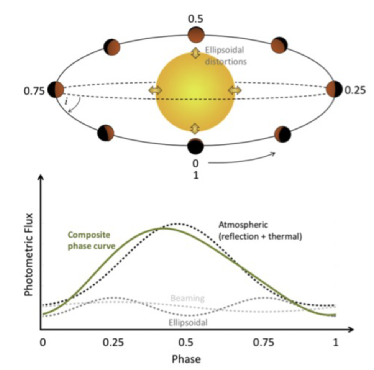
A schematic showing the three-phase curve components atmospheric modulation, tidal ellipsoidal distortion, and Doppler beaming. Top panel: The orbital path of a non-transiting planet showing the atmospheric phases and tidal ellipsoidal distortions. Bottom panel: The individual phase curve components from a light curve (dashed lines) and total phase curve shape (solid green line) (Image credit: Lillo-Box et al. 2021).
Spectroscopic
Transit photometric lightcurves combined with RV measurements provide details on planetary masses, composition and the overall nature of systems. However, inhomogeneities (such as granulation, plage/faculae and spots) on the surfaces of Sun-like stars induce velocity signals which can swamp the signal from a rocky, temperate planet.
When a planet transits a host star, a portion of the starlight is blocked from the line of sight and a distortion of the velocities is observed, known as the Rossiter-McLaughlin (RM) effect. The reloaded-RM (RRM) technique, isolates the blocked starlight behind the planet to spatially resolve the stellar spectrum. This starlight can be used to detect and characterise both stellar differential rotation (DR) and centre-to-limb convection-induced variations (CLV), and to determine star-planet obliquities. Stellar surface phenomena, such as DR and CLV, alters the observed stellar line profiles and can induce Doppler shifts which can mask/mimic the effects of planetary companions.
Stellar surfaces are covered in granules, bubbles of hot plasma which rise to the surface, cooling and falling back into intergranular lanes. The net convective velocity shift caused by these granules changes as a function of limb angle (i.e. from the centre to the limb of the star) due to line-of-sight changes. Overall, these velocity shifts can impact the RM effect which is used to determine the projected obliquity. Therefore, ignoring the velocity contributions caused by granulation can bias or skew these measurements and impact our understanding of planet formation and evolution. Furthermore, DR plays a critical role in dynamo processes which are largely responsible for the generation of magnetic fields. Therefore, understanding DR and CLV are not just important for exoplanet characterisation, but for magnetic activity as a whole. Additionally, determining the projected 2D and true 3D obliquities of systems is of particular importance when considering planet formation, migration, and evolution.
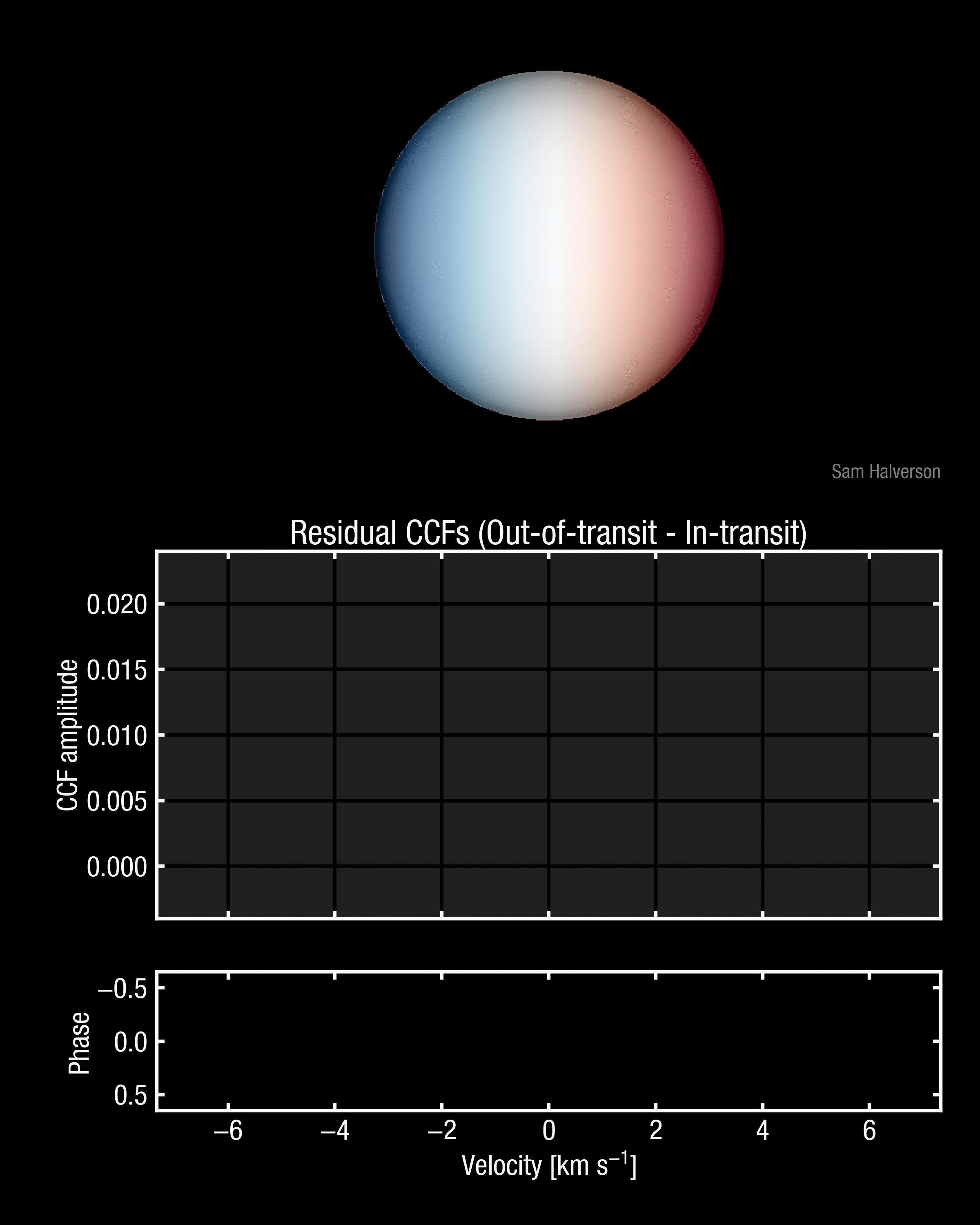
A GIF showing the Reloaded Rossister McGlaughlin Technique. This involves isolating starlight behind the planet by subtracting in-transit observations from out-of-transit observations. The video shows this isolated starlight where we are operating on the cross-correlation function or CCF in the middle panel. The CCF is a composite of all the absorption spectral lines and we scale the CCFs using transit light curves allowing for their direct subtraction. The very bottom panel is a top-down view of the CCFs where you can see a change in velocity represented by the CCF centroid as the planet tracks across the star. (GIF credit: Sam Halverson)
Solar Flares
Solar flares represent sudden increases in radiation which result from a rapid reconfiguration of the coronal magnetic field. Overall, these events are extremely powerful and are observed across the entire electromagnetic spectrum, possessing energy outputs up to 1032 erg. Magnetic energy released from solar flares can be observed as multiple phenomena including flare ribbons and post-flare arcades, but also in filament eruptions, coronal mass ejections (CME's) and blow-out jets. Overall, the pre-flare magnetic topology is responsible for deciding which of these phenomena will manifest to produce a solar flare.
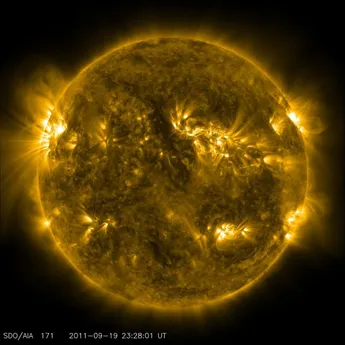
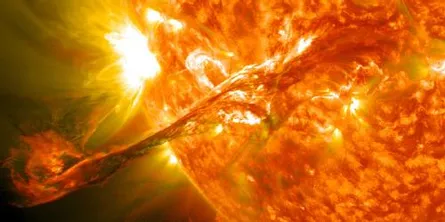 Image Credit: NASA
Image Credit: NASA
Recently I have been working on ground-and-space-based solar observations from the Swedish Solar Telescope and Solar Dynamics Observatory of a solar flare event associated with a filament eruption and jet, which has been compared to a 3D MHD simulation (Doyle et al. 2019b). These observations provide the evidence to validate the simulation which can be applied to not only jets and CMEs but also confined eruptions and flares. Overall, the magnetic configuration observed in the event and in the simulation can be applied to multiple eruptive phenomena on the Sun. In turn, this can then be applied to stellar scenarios, scaling up the simulation to replicate flare energies observed in other stars. By monitoring the effects this has on the size and strength of sunspots we can determine whether it is likely these flares are generated through a similar magnetic field configuration or if it is more complex. Through this process, it is difficult to replicate the higher energies with realistic magnetic field strengths and spot sizes.
Stellar Flares
In addition to solar flares, stellar flares from both low-mass and solar-type stars have been observed over many decades with energies greatly exceeding 1033 erg. Known as ‘superflares’ these large outbursts can have severe consequences for any orbiting planet’s atmosphere, therefore, understanding their frequency and origin is vital for the existence of life.
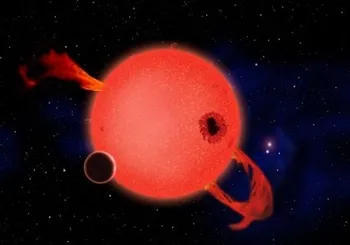
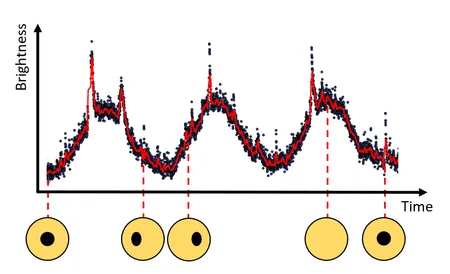
Image Credit: NASA & L. Doyle
The brightness of many stars show periodic changes as the star rotates (see image above). This is widely thought to be the result of a dominant, large starspot/active region which is cooler than its surroundings and rotating in and out of view. From observations of the Sun, we know flares typically originate near sunspots, so it is natural to expect flares to originate from starspots in other stars. If the analogy between solar and stellar flares holds, then we would expect to see a correlation between the timing of stellar flares and flare number. I led two studies (Doyle et al. 2018, 2019) using one and two-minute photometric data from K2 and TESS to investigate the timing of flares in samples of 34 and 149 M dwarfs respectively. Utilising a simple statistical test, we investigated whether the distribution of the flares was random and concluded none of the stars in the sample show any preference for certain phase distributions. This is a big surprise, as it implies other stars do not behave like the Sun!
Publications
A full list of my publications and citations can be found on Google Scholar here.
REFEREED (First author)
Doyle L., Cegla H. M., Bryant E., Bayliss D., Lafarga M., et al., (2022b), The Hot Neptune WASP-166 b with ESPRESSO I: Refining the Planetary Architecture and Stellar Variability, MNRAS, 522 (3), 4499-4514, doi.org/10.1093/mnras/stad1240
Doyle L., Bagnulo S., Ramsay G., Doyle J. G., Hakala P., (2022a), The puzzling story of flare inactive ultra-fast rotating M dwarfs – I. Exploring their magnetic fields, MNRAS, 512(1), 979–988, doi.org/10.1093/mnras/stac464
Doyle L., Ramsay G., Doyle J. G., (2020), Superflares and Stellar Variability on Solar-Type Stars Using TESS, MNRAS, 494(3), 3596-3610, doi:10.1093/mnras/staa923
Doyle L., Wyper P., Scullion E., et al., (2019b), Observations and 3D MHD Modeling of a Confined Helical Jet Launched by a Filament Eruption, ApJ, 887(2), 256, doi:10.3847/1538-4357/ab5d39
Doyle L., Ramsay G., Doyle J. G., Wu K., (2019a), Probing the Origin of Stellar Flares on M dwarfs Using TESS Sectors 1 - 3, MNRAS 489, 437-445, doi:10.1093/mnras/stz2205
Doyle L., Ramsay G., Doyle J. G., Wu K., Scullion E., (2018), Investigating the Rotational Phase of Stellar Flares on M dwarfs using K2 Short Cadence Data, MNRAS, 480, 2153-2164, doi:10.1093/mnras/sty1963
REFEREED (Co-author)
Lafarga M., Cegla H. M., Doyle L., Brogi M., et al., (2022), The Hot Neptune WASP-166 b with ESPRESSO III: Searching for Water in the Planetary Atmosphere, MNRAS, 521 (1), 1233-1252, doi.org/10.1093/mnras/stad480
Seidel J. V., Cegla H. M., Doyle L., et al., (2022), The Hot Neptune WASP-166 b with ESPRESSO II: Confirmation of
atmospheric sodium, MNRASL, 513 (1), L15-L19, doi.org/10.1093/mnrasl/slac027
Ramsay G., Hakala P., Doyle J. G., Doyle L., Bagnulo B., (2022), The Puzzling Story of Flare Inactive Ultra Fast Rotating M dwarfs. II. Searching for radial velocity variations, MNRAS, 511(2), 2755–2764, doi.org/10.1093/mnras/stac188
Ramsay G., Kolotkov D., Doyle J. G., Doyle L., (2021), TESS Observations of Flares and Quasi-Periodic Pulsations from Low Mass Stars and Potential Impact on Exoplanets, Sol Phys, 296, 162, doi.org/10.1007/s11207-021-01899-x
Ramsay G., Doyle J.G., Doyle L., (2020), TESS observations of southern ultrafast rotating low-mass stars, MNRAS, 497 (2), 2320-2326, doi:10.1093/mnras/staa2021
Talks and Posters
During my academic career, I have given talks and presented posters on my research at a variety of conferences. To date, I have presented a total of 20 oral presentations (including 3 seminars and 4 invited talks) and 7 posters.
ORAL PRESENTATIONS
March 2023 EPRV 5, Santa Barbara, US
May 2022 Invited Seminar at Armagh Observatory, UK
May 2022 Exoplanets IV, Las Vegas, US
March 2022 Invited Seminar at Glasgow University, UK
March 2022 Invited Seminar at MSSL University, UK
December 2021 Research Talk for the Warwick Astronomy Society, UK
May 2021 ERES, Penn State, US
April 2021 UKEXOM, Birmingham UK
POSTER PRESENTATIONS
June 2022 EAS 2022, Valencia, Spain
July 2021 TESS Science Meeting II, Nasa, US
Outreach
One of my main reasons for pursuing an academic research career is my passion for astronomy which I have held since I was a young girl! Communicating my research to the public and inspiring new scientists is something I am very passionate about. During my academic career, I have organised and delivered many large events ranging from public talks to in-school workshops and even co-writting a science activity book.
While a postdoctoral researcher at Warwick, I have been worked with many groups across the university including the Physics Department, Warwick Arts Centre, WMG, Chemistry Department and the Warwick Institute of Engagement (WIE).
Planetarium Shows
One of my favourite outreach events is planetarium shows which I have been delivering for over ten years. The reaction from the audience as you take them on a tour of the night sky is something I will never tire of. It is also an amazing resource to talk about a lot of topics within astronomy from how stars form to other galaxies in our universe. Astronomy is such a tangible science, anyone can look up at the stars and search the sky to find hidden wonders. Star gazing is also accessible to everyone and is the most popular topic requested in the planetarium. Being able to talk about and explain my research and how important it is to society while making it still accessible to all is something which is extremely important to me.
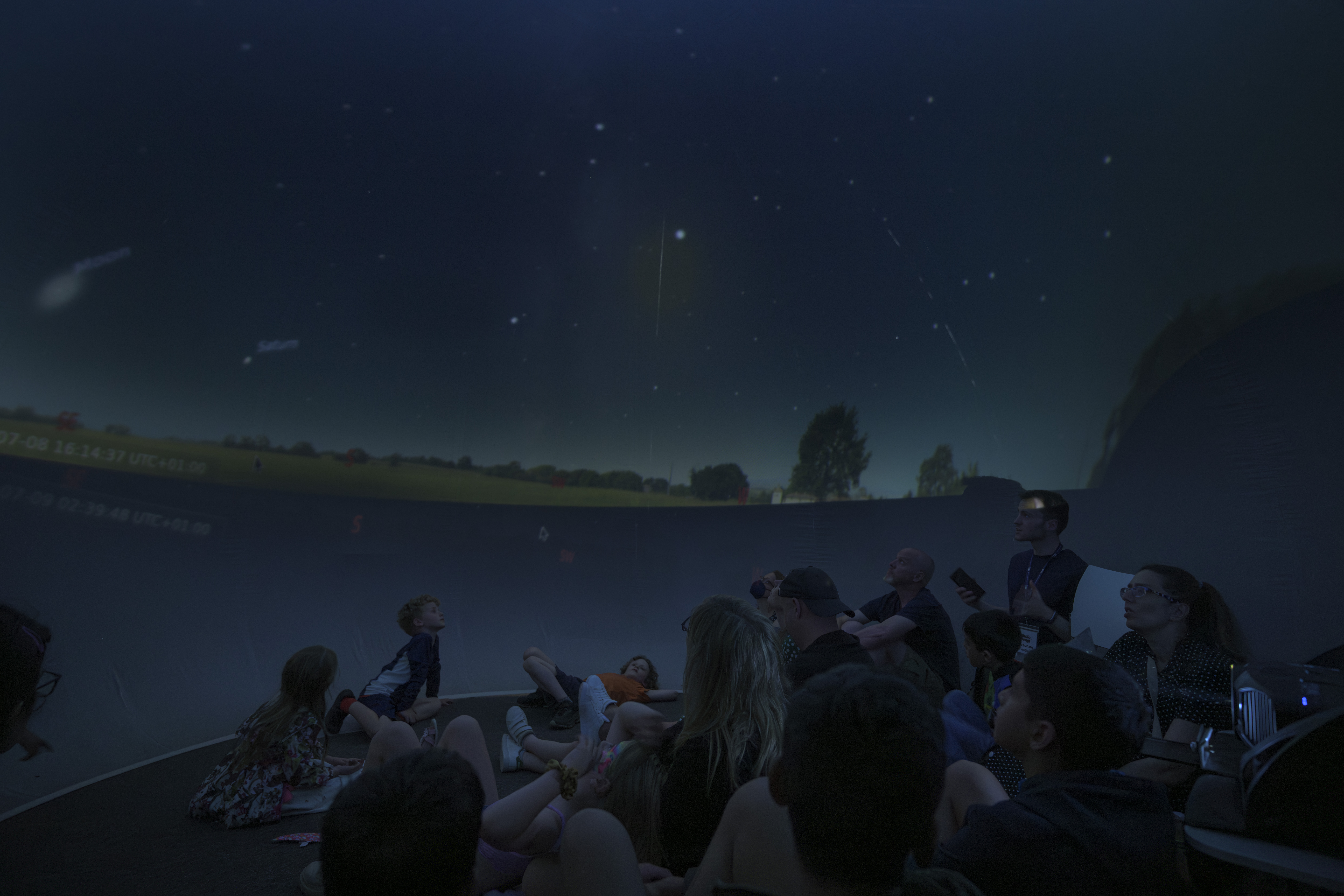
A picture of the blow-up mobile planetarium I have worked with over the years.
The Big Bang Fair
We were supported by Engineering UK at the Big Bang Fair which is hosted yearly at the NEC in Birmingham. This is a massive event where companies and universities come from across the UK to promote STEM careers to Year 6 – 9 pupils. This event ran over three days in late June and as part of this, I was responsible for organising our stand and managing the staff who would be working. For this event, I was awarded some funds by WIE to purchase our Astro Table which is a touch table running the software 'Stellar Playground' by Clark Planetarium. It is an interactive software which allows users to experience and explore stellar life cycles, gravitational/orbital mechanics, and the advancement of civilizations by dragging and dropping stars and other exotic celestial objects.
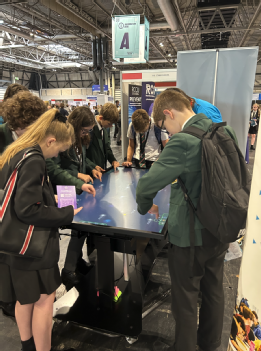
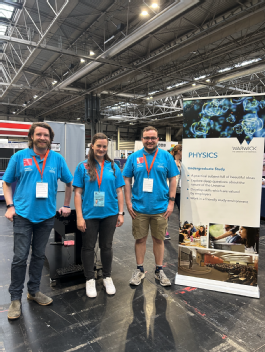
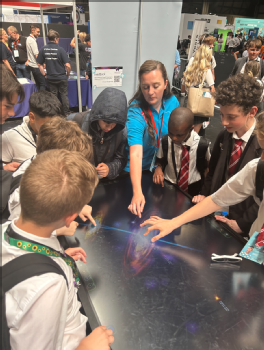
A selection of images from the Big Bang Fair 2023 showing our Astro table in action!
Physics Christmas Lectures
In December 2022 I was selected as one of six researchers to give a presentation at the Warwick Physics Christmas Lectures at the Warwick Arts Centre. This involved me giving a 20-minute presentation explaining what an exoplanet is and how we find them! This lecture was presented to an audience of 900 people in the Butterworth Hall and was an amazing experience involving bigger-than-life demonstrations and the opportunity for me to explain my research to such a large audience.
Since then, I have adapted my presentation and delivered it as a 40-minute lesson in many schools across the UK including Coventry, Birmingham and Glasgow!
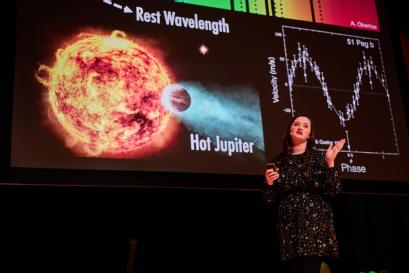
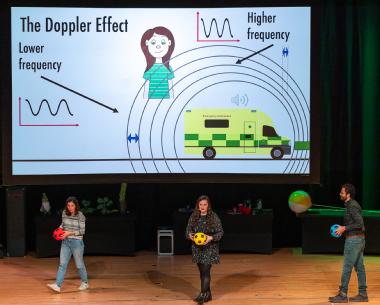
A couple of pictures from my presentation at the Warwick Christmas Lecture in December 2022.
Other Events
Other events I have been involved in:
- Slice of Science & Resonate Festival: Slice of Science and Resonate Festival are annual events at the University of Warwick run by the Warwick Institute of Engagement, bringing together many different research groups from across science. As part of these events I have delivered a 30-minute public talk, ran workshops on many of the areas of research within the Astronomy and Astrophysics group, delivered planetarium shows and showcased our Astro Table.
- Space Camps: Space Camp is an overnight stay at schools in the Sutton Coldfield area for Year 5
pupils to give them an insight into topics related to Space. As part of this, I have volunteered over the past few years to deliver multiple talks at several schools over the month of November on the topic of stars from
how they are born to how they die. - Warwick Giving Day: Giving Day is the University of Warwick’s annual 36-hour fundraising
challenge, bringing together our community to show support for current and future students at
Warwick. I was asked to be interviewed to promote and represent the Astronomy and Astrophysics
Group as part of Giving Day. - National Astronomy Meeting (NAM): For NAM 2022 I was responsible for organising and delivering
eight fully booked shows in the departments' blow-up planetarium for the public Hands on Science
workshop. I was also involved in leading one of the morning sessions for Year 5 pupils on the Sun
and stars for which I received excellent feedback.
Write to:
Lauren Doyle,Contact details:
Full CV → here
